|
Click pictures for a larger version.
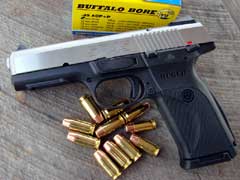
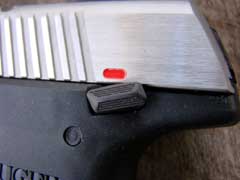


Ambidextrous safety levers.


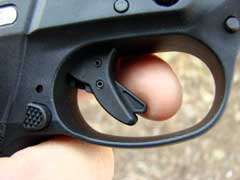


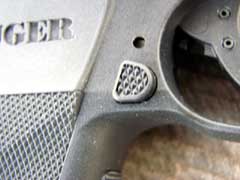
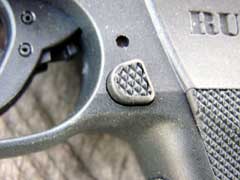
Ambidextrous magazine release buttons.

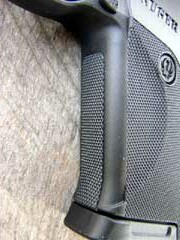

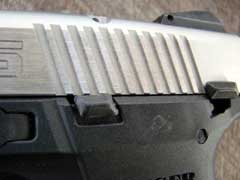
Slide lock.

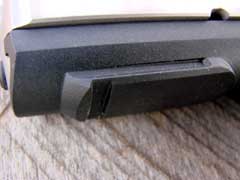
Accessory rail.

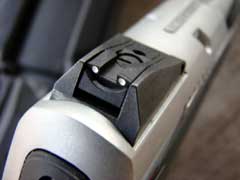
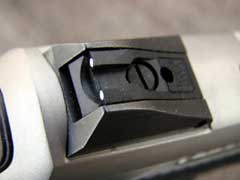

Excellent set of sights, with the rear
fully-adjustable.
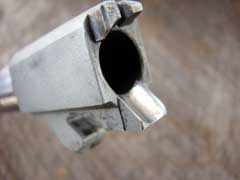
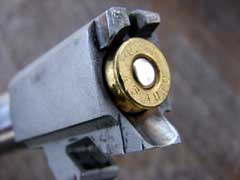
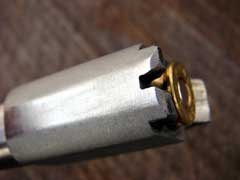
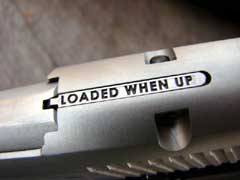
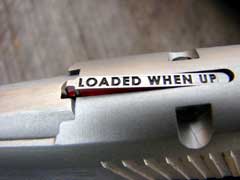
Visual and tactile loaded-chamber indicator.

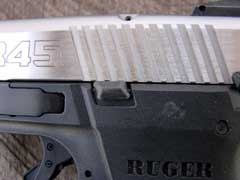
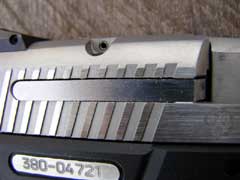
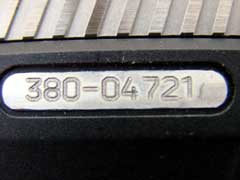

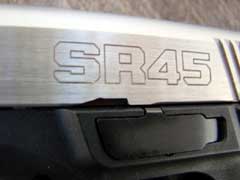
|
|
Since the introduction of the Ruger
SR9 back in 2007, shooters have been asking for that pistol
to be chambered for the 45 ACP cartridge. The SR9 was Ruger’s
entry into the striker-fired auto loading pistol market, and it
has met with great success. Followed by both the compact
SR9c and the full-sized SR40 in
2010, as well as the SR40c, the SR series of pistols have proven
to be very reliable, while having the softest recoil that I have
felt compared to other competitive pistols on the market. The SR
pistols sit low in the hand, and the size and shape of the grip
handles the recoil extremely well.
For those who have been waiting, the SR45 is
finally here, boasting all the traits of the SR family of
pistols, in a very slightly larger package. I won’t go into
every last detail of the SR pistols here, as we have covered
that already in previous reviews, but I will hit the high spots
of the design. As mentioned, the SR pistols are striker-fired,
instead of having a hammer and firing pin arrangement. This
design allows the weapon to sit lower in the shooter’s hand.
The SR pistols have many safety features, including ambidextrous
manual safety levers, a visual and tactile loaded-chamber
indicator, a passive striker safety, and an articulated safety
within the trigger blade. The SR pistols also have a
magazine-disconnect safety, to prevent firing with the magazine
removed. In addition, the SR pistols have ambidextrous magazine
release buttons, and a left-side slide lock. An accessory rail
is provided, integral with the polymer frame, to accept a laser,
flashlight, or other accessory.
Disassembly of the SR pistol is very simple,
requires no tools, and the trigger does not have to be pulled to
accomplish disassembly, as is necessary on some competitive
designs. The sights are of the three-dot pattern, are made
primarily of steel, and the rear is adjustable for both windage
and elevation correction.
The new SR45 pistol has all the features of
the other SR pistols, but is chambered for the most American of
pistol cartridges, the grand old 45 ACP. The 45 ACP is a proven
cartridge, which has served the needs of military, law
enforcement, personal defense, and competition shooting for more
than one hundred years. The cartridge itself needs no fanfare to
introduce it, but this SR45 is Ruger’s latest pistol to be
chambered for the cartridge.
For many years, Ruger’s only 45 ACP
autoloader was the excellent P90. Like other hammer-fired P
Series pistols, the P90 was reliable and accurate, but a bit on
the bulky side. Ruger later introduced their polymer-framed
P345, which was lighter and more compact than the P90, but
both of those have now been discontinued. The Ruger SR1911 45
ACP has met with tremendous success in the marketplace, and is
still going strong, but this new SR45 meets the needs of those
who want a thoroughly modern polymer-framed 45, with the
durability, reliability, and value of a Ruger. The SR45 does not
disappoint.
Ruger has managed to fit a ten shot
double-stack magazine into a package that is only slightly
larger than the 40 S&W caliber SR40. In fact, the grip width
of the SR9, SR40, and SR45 are the same. Front to back, the SR45
is only about eight one-hundredths (.08) of an inch larger.
Trigger reach is only six one-hundredths (.06) inch longer for
the SR45. The SR45 feels very little different from holding an
SR40. The grip is well-textured for a secure hold, and has a
reversible backstrap, changing from arched to flat, to suit the
shooter’s preference.
Critical specifications for the SR45, along
with a comparison to the SR40, are listed in the chart below.
Weights are listed in ounces. Linear dimensions are listed in
inches. Trigger pull is listed in pounds of resistance, as
measured with my Lyman digital trigger pull scale. Height
includes sights and magazine base pad. Maximum width is measured
across the top of the frame, and includes the ambidextrous
safety levers.
| |
SR40 |
SR45 |
| Chambering |
40 S&W |
45 ACP |
| Weight with Empty Magazine |
27.4 oz. |
30.1 oz. |
| Trigger Pull |
6 lbs, 5 oz. |
6 lbs, 6 oz. |
| Barrel Length |
4.14" |
4.51" |
| Barrel Diameter |
0.565" |
0.595" |
| Overall Height |
5.57" |
5.72" |
| Overall Length |
7.5" |
7.875" |
| Grip Thickness |
1.18" |
1.18" |
| Slide Thickness |
1.06" |
1.06" |
| Maximum Width |
1.27" |
1.27" |
| Trigger Reach |
2.68" |
2.74" |
| Magazine Capacity |
15 |
10 |
| Magazines Supplied |
2 |
2 |
| Sights |
3-Dot, Adjustable |
3-Dot, Adjustable |
| Accessory Rail |
Yes |
Yes |
I tested for velocity with my
chronograph set at ten feet from the muzzle, and an air
temperature of forty-nine degrees Fahrenheit and a relative
humidity of fifty-four percent. Velocity readings were taken at
an elevation of approximately 541 feet above sea level.
Velocities are listed in the chart below, and are listed in
feet-per-second (fps). FMJ is a full metal jacket bullet. HCL is
a hard-cast lead bullet. JHP is a jacketed hollowpoint. DPX is
an homogenous copper hollowpoint bullet. Glaser is a specialty
pre-fragmented core inside a copper alloy jacket. PB is Pow’RBall.
LFHP is a Barnes lead-free homogenous copper hollow point
bullet. LSWC is a cast lead semi-wadcutter bullet. UHD is
Remington Ultimate Home Defense hollowpoint ammunition. Bullet
weights are listed in grains.
| Ammunition |
Bullet Weight |
Velocity |
| Buffalo Bore JHP |
230 |
938 |
| Buffalo Bore FMJ |
230 |
951 |
| Buffalo Bore LFHP |
185 |
1122 |
| Buffalo Bore JHP |
185 |
1110 |
| Buffalo Bore HCL |
255 |
960 |
| Cor-Bon JHP |
200 |
1034 |
| Cor-Bon JHP |
165 |
1117 |
| Cor-Bon JHP |
230 |
893 |
| Cor-Bon DPX |
185 |
944 |
| Cor-Bon PB |
165 |
1141 |
| Cor-Bon Glaser |
145 |
1111 |
| Stryker JHP |
185 |
784 |
| Atomic HP |
230 |
911 |
| Remington FMJ |
230 |
786 |
| Remington UHD |
230 |
789 |
| Handload LWSC |
200 |
975 |
| WCC 1911 Ball FMJ |
230 |
748 |
Functioning of the Ruger SR45 was perfect
with every type of ammunition tested. Every cartridge fed,
fired, and ejected flawlessly. The magazines were difficult to
load by hand as the mag reached full capacity, but thankfully,
Ruger includes a magazine loader with the SR45, which makes the
task much easier. For accuracy testing, I held the SR45 rested
across a Target
Shooting, Inc. pistol rest, firing on paper at a distance of
twenty-five yards. The P90 has always had a stellar reputation
for accuracy, so the SR45 had a tough act to follow, but
accuracy was excellent with almost every load tested. Accuracy
varied from superb to very good, with the least-accurate
ammunition grouping in the two and one-half inch range, and the
better loads running about half that group size. The
best-performing loads are pictured here, and would be suitable
for the toughest competition. Bullet weights from 185 to 255
grains all grouped very well from this SR45. The trigger pull
was smooth, making the SR45 easy to hold on target.
The SR45, like the other SR Series pistols,
is priced below most of its competition. As of the date of this
review, the MSRP is only $529 US. The SR45 is loaded with
features, and comes packed in a hard storage case, with
instructions, cable lock, two magazines, and a magazine loading
tool. The SR45 is built right, and is built in the USA.
Check out the extensive line of Ruger
firearms and accessories online at www.ruger.com.
For the location of a Ruger dealer near you,
click on the DEALER FINDER at www.lipseys.com.
To order the SR40 online, go to www.galleryofguns.com.
To order quality 45 ACP ammunition, go to www.buffalobore.com,
www.midsouthshooters.com,
and www.luckygunner.com.
Jeff Quinn
  
Got something to say about this article?
Want to agree (or disagree) with it? Click the following link to
go to the GUNBlast Feedback Page.
|
|
Click pictures for a larger version.
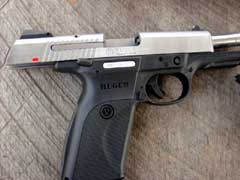
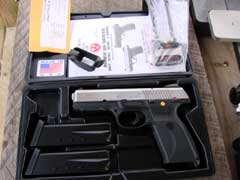

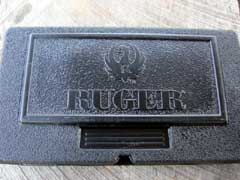
SR45 comes with case, instructions, two ten-round
magazines, cable lock, and magazine loading tool.
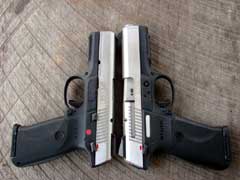



SR45 (right) compared to SR9 (left).

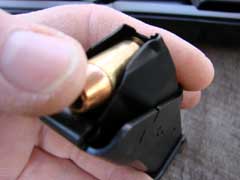
Magazine loading tool makes loading the magazines to
capacity much easier.
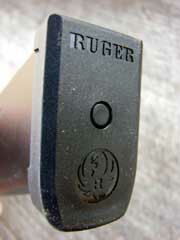
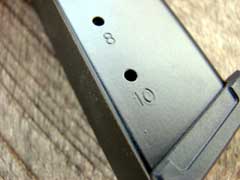
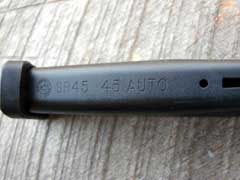
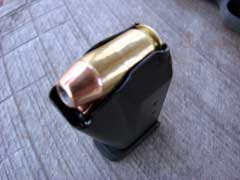
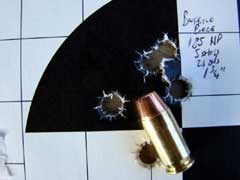
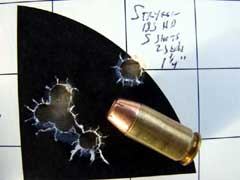
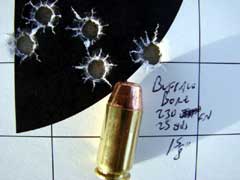

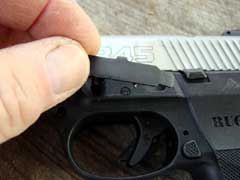
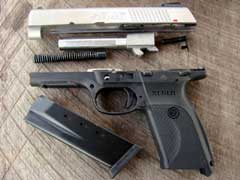
Disassembly is easy, and requires no tools.
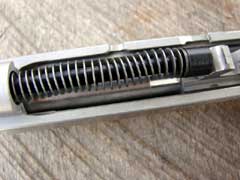
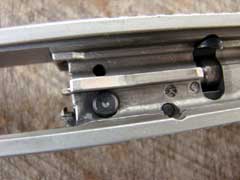
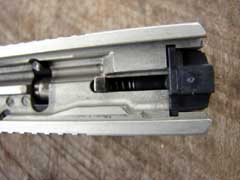

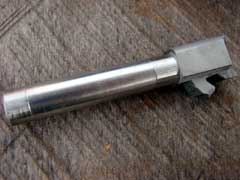
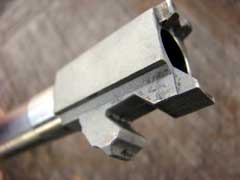

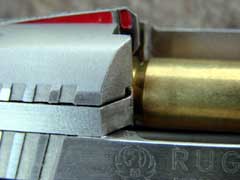
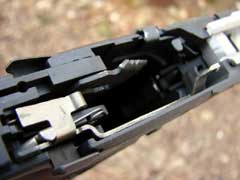
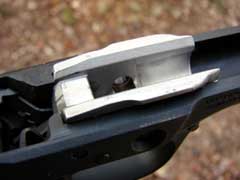
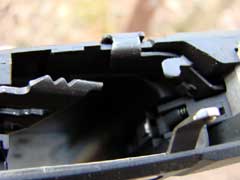
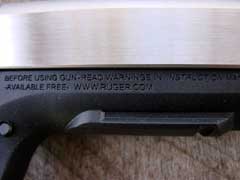
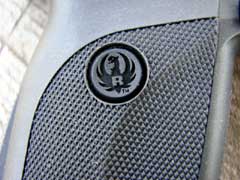

|
![]()